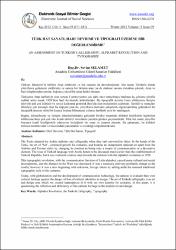| dc.contributor.author | Selamet, Sevim | |
| dc.date.accessioned | 2019-10-20T14:28:49Z | |
| dc.date.available | 2019-10-20T14:28:49Z | |
| dc.date.issued | 2012 | |
| dc.identifier.issn | 1304-0278 | |
| dc.identifier.uri | http://www.trdizin.gov.tr/publication/paper/detail/TVRNd01EWTNOdz09 | |
| dc.identifier.uri | https://hdl.handle.net/11421/18251 | |
| dc.description.abstract | Türkler, islamiyet’le birlikte Arap alfabesini ve hat sanatını da devralmıslardır. Hat sanatı Türklerin elinde yüzyıllarca gelisimini sürdürmüs ve sadece bir iletisim aracı ya da süsleme unsuru olmaktan çıkarak, Arap ve İran üsluplarından ayrılan, bağımsız ulusal bir sanat halini almıstır. Türkçenin Arap harfleriyle olan sorunu Cumhuriyetten çok daha önce tartısılmaya baslansa da, çözüme yönelik radikal adım ancak 1928’deki harf devrimiyle atılabilmistir. Bu tipografik devrim Latin alfabesinin iletisim isleviyle pek çok kültürel ve sosyal kalkınma getirerek Batı'yla olan mesafemizi azaltmıstı. Gerekli ve sonuçları itibariyle çok kazançlı olan bu değisim yine de, yüzyıllarca üzerinde çalısılarak olgunlastırılmıs geleneksel bir tipografik tasarım stilini bir kenara bırakıp bilinmeyen yabancı harflerle yeni bir baslangıçtı. Bugün, küresellesme ve iletisim teknolojilerindeki gelisimle birlikte tasarımda kültürel kimliklerin kaybolma tehlikesine karsı pek çok ulus kendi kültürel miraslarını yeniden gözden geçirmektedir. Türk hat sanatı yüzyıllar boyunca kendi kimliğimizle saheserler ürettiğimiz bir sanat ve tasarım alanıdır. Bu çalısmada, bu kültürel mirasın modern sanat ve tasarımdaki yansımaları ve eksikliği sorgulanmaktadır. | en_US |
| dc.description.abstract | The Turks adapted the Arabic alphabet and calligraphy when they had converted to Islam. In the hands of the Turks, the art of hat”, continued growth for centuries, and became an independent national art apart from the Arabian and Persian styles by changing its position as being only a means of communication or a decorative element. The issue of Turkish language with Arabic letters to be discussed much earlier than the establishment of Turkish Republic, but it was ventured a radical step towards the solution with the alphabet revolution in 1928. This typographic revolution, with the communication function of Latin alphabet, caused many cultural and social developments, and the distance to the West was decreased. It was a necessary and very profitable change as the results; however it was a new beginning with unknown, foreign letters by setting aside the matured traditional typographic style of the centuries. Today, with globalization and the development of communication technology, the nations re-evaluate their own cultural heritage against the danger of loss of cultural identities in design. The art of Turkish calligraphy is an art and design area which we created masterpieces in it with our own identity for centuries. In this paper, it is questioning the reflection and deficiency of this cultural heritage in the modern art and design. | en_US |
| dc.language.iso | tur | en_US |
| dc.rights | info:eu-repo/semantics/openAccess | en_US |
| dc.subject | Sosyal Bilimler | en_US |
| dc.subject | Disiplinler Arası | en_US |
| dc.title | Türk hat sanatı, harf devrimi ve tipografi üzerine bir değerlendirme | en_US |
| dc.title.alternative | An assessment on Turkish calligraphy, alphabet revolution and typography | en_US |
| dc.type | other | en_US |
| dc.relation.journal | Elektronik Sosyal Bilimler Dergisi (elektronik) | en_US |
| dc.contributor.department | Anadolu Üniversitesi, Güzel Sanatlar Fakültesi | en_US |
| dc.identifier.volume | 11 | en_US |
| dc.identifier.issue | 39 | en_US |
| dc.identifier.startpage | 171 | en_US |
| dc.identifier.endpage | 183 | en_US |
| dc.relation.publicationcategory | Diğer | en_US] |


















